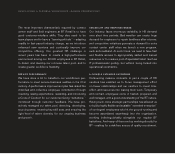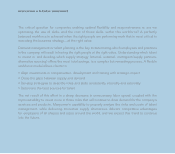ManpowerGroup 2004 Annual Report Download - page 17
Download and view the complete annual report
Please find page 17 of the 2004 ManpowerGroup annual report below. You can navigate through the pages in the report by either clicking on the pages listed below, or by using the keyword search tool below to find specific information within the annual report.
As a worldwide business operating in the fast-moving
consumer goods sector, we need a first-rate permanent
labor force for ongoing operations, as well as additional
temporary staff for periods of seasonality, such as for
ice cream and frozen vegetables. While the nature of our
business means employing predominantly local people at
all levels, our management population includes expatriates,
as we like our higher leadership to have had experience
in several parts of the Unilever world.
SIMULTANEOUSLY BIG AND SMALL
Rather than a global company, we see ourselves as a
multi-local multinational. Our greatest challenge is to
combine the flexibility of a small organization with the
impact of a big company. Intense competition and the
ever-changing environment within our industry impose a
constant need to find new and more efficient ways of
doing business – and to stay flexible and adaptable.
The global scope of our business and the local nature of
our customer base together lent themselves to taking a
regional approach to our manufacturing supply chain. We
have closed facilities in some areas and expanded them
in others, with a resulting reduction in manufacturing
plants from 500 to 350; we rationalized our brand range
from 1,600 to some 400 by introducing more global
brands; and we significantly reduced the number of our
vendors. While this has helped us improve on being big,
we have also improved on being small, for example by
having local “marketeers” regularly visit consumers’
homes to understand their specific needs and achieve
“consumer intimacy.”
OUTSOURCING FOR FLEXIBILITY
Regionalization has brought scale benefits and a concen-
tration of assets that has enabled us to view our workforce
more strategically and develop skills over a longer time-
frame. We have gained workforce flexibility by outsourcing
recruitment of seasonal and temporary staff, as well as
the provision of contract specialists to augment skills in
areas such as IT. Further candidate functions that we
have identified for handling at a regional level, and possible
outsourcing, lie in the transactional administration activities
of HR and Finance. The objective is to free up our HR
and Finance managers to concentrate on more strategic,
transformational activities.
OUTSOURCING HR SERVICES (VAN HEEMSTRA PERSPECTIVE)
























